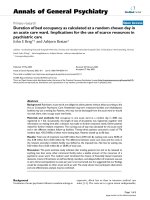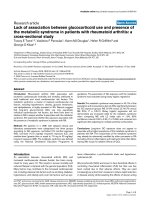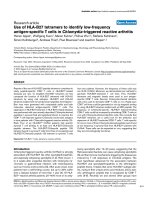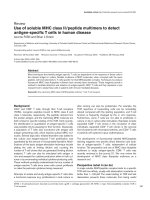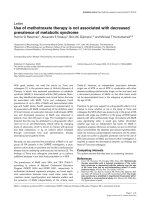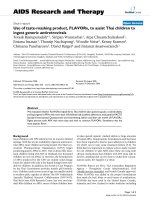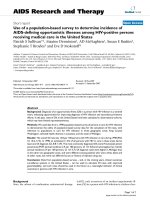Báo cáo y học: "Use of a population-based survey to determine incidence of AIDS-defining opportunistic illnesses among HIV-positive persons receiving medical care in the United States" ppsx
Bạn đang xem bản rút gọn của tài liệu. Xem và tải ngay bản đầy đủ của tài liệu tại đây (237.92 KB, 7 trang )
BioMed Central
Page 1 of 7
(page number not for citation purposes)
AIDS Research and Therapy
Open Access
Short report
Use of a population-based survey to determine incidence of
AIDS-defining opportunistic illnesses among HIV-positive persons
receiving medical care in the United States
Patrick S Sullivan*
1
, Maxine Denniston
1
, AD McNaghten
1
, Susan E Buskin
2
,
Stephanie T Broyles
3
and Eve D Mokotoff
4
Address:
1
Centers for Disease Control and Prevention, Division of HIV/AIDS Prevention, 1600 Clifton Road NE, MS E46, Atlanta GA 30333, USA,
2
Public Health – Seattle & King County, 400 Yesler Way, 3rd Floor, SeattleWA 98104, USA,
3
Louisiana Department of Public Health, 2021
Lakeshore Dr. Ste 210, New Orleans LA 70122, USA and
4
Michigan Department of Community Health, 1151 Taylor, Rm 211B Herman Kiefer
Health Complex, Detroit MI 48202, USA
Email: Patrick S Sullivan* - ; Maxine Denniston - ; AD McNaghten - ;
Susan E Buskin - ; Stephanie T Broyles - ; Eve D Mokotoff -
* Corresponding author
Abstract
Background: Diagnosis of an opportunistic illness (OI) in a person with HIV infection is a sentinel
event, indicating opportunities for improving diagnosis of HIV infection and secondary prevention
efforts. In the past, rates of OIs in the United States have been calculated in observational cohorts,
which may have limited representativeness.
Methods: We used data from a 1998 population-based survey of persons in care for HIV infection
to demonstrate the utility of population-based survey data for the calculation of OI rates, with
inference to populations in care for HIV infection in three geographic areas: King County
Washington, selected health districts in Louisiana, and the state of Michigan.
Results: The overall OI rate was 13.8 per 100 persons with HIV infection in care during 1998 (95%
CI, 10.2–17.3). In 1998, an estimated 11.3% of all persons with HIV in care in these areas had at
least one OI diagnosis (CI, 8.8–13.9). The most commonly diagnosed OIs were Pneumocystis jiroveci
pneumonia (PCP) (annual incidence 2.4 per 100 persons, CI 1.0–3.8) and cytomegalovirus retinitis
(annual incidence 2.4 per 100 persons, CI 1.0–3.7). OI diagnosis rates were higher in Michigan than
in the other two geographic areas, and were different among patients who were white, black and
of other races, but were not different by sex or history of injection drug use.
Conclusion: Data from population-based surveys – and, in the coming years, clinical outcomes
surveillance systems in the United States – can be used to calculate OI rates with improved
generalizability, and such rates should be used in the future as a meaningful indicator of clinical
outcomes in persons with HIV infection in care.
Background
Since the advent of combination antiretroviral therapy
(cART), each occurrence of an incident opportunistic ill-
ness (OI) in a person with HIV infection is a failure of sec-
Published: 12 September 2007
AIDS Research and Therapy 2007, 4:17 doi:10.1186/1742-6405-4-17
Received: 10 May 2007
Accepted: 12 September 2007
This article is available from: />© 2007 Sullivan et al; licensee BioMed Central Ltd.
This is an Open Access article distributed under the terms of the Creative Commons Attribution License ( />),
which permits unrestricted use, distribution, and reproduction in any medium, provided the original work is properly cited.
AIDS Research and Therapy 2007, 4:17 />Page 2 of 7
(page number not for citation purposes)
ondary HIV prevention: new OI diagnoses may represent
a failure of early diagnosis of HIV infection, failure to link
a diagnosed person to effective medical care, failure to
prescribe cART and/or OI prophylaxis when indicated,
problems with adherence to cART and/or OI prophylaxis,
or drug-resistant HIV infection that is not adequately con-
trolled by prescribed cART. Reliable population-based
estimates of OI incidence are thus a high-level measure of
multiple goals of prevention and care programs, reflecting
both the extent to which persons with HIV are being diag-
nosed early in the course of disease and entering care in a
timely way, and the quality and effectiveness of that care.
High overall OI incidence may indicate prevalent prob-
lems with late diagnosis of HIV infection or failure to
enter care. Some specific OI diagnoses among persons in
care may indicate failures of specific OI prophylaxis meas-
ures. For example, prophylaxis against Pneumocystis jiroveci
pneumonia (PCP) and Mycobacterium avium complex
(MAC) should be provided according to guidelines, and
these guidelines may not be strictly followed for various
reasons [1]. Understanding the incidence and trends of
other OIs may be useful for resource planning, because
OIs can be costly to treat.
The present sources of data on OI incidence and preva-
lence in the United States have significant limitations.
Since 1993, when CD4 T-lymphocyte count <200 cells/µL
became an AIDS-defining condition in the United States
[2] (although not in Europe [3]), US AIDS surveillance
programs have seen a decrease in the collection of infor-
mation on OI diagnoses. Fewer OI diagnoses are reported
at the time of AIDS diagnosis because immunologically-
defined AIDS usually occurs before an AIDS-OI; over 60%
of new AIDS cases in the United States are reported based
on CD4 count, with no AIDS-OI [4]. Subsequent OI diag-
noses are also undercaptured because, in most US states,
surveillance resources are not adequate to conduct fol-
lowup investigation of OI diagnoses among AIDS cases
initially reported as AIDS using the immunological crite-
rion. Although observational cohort studies have served
as an important source of information about OI incidence
in selected populations, these studies are not representa-
tive of all persons in care for HIV infection, and are there-
fore subject to significant biases [5]. Ideally, population-
based data sources should be used to monitor OI inci-
dence over time, to provide an understanding of trends in
OIs in the entire population of HIV-infected patients in
care.
Methods
Using data from a 1998 pilot study to demonstrate the use
of population-based methods for clinical outcomes sur-
veillance (the Survey of HIV Disease and Care, or SHDC),
the incidence of OIs was calculated in three geographic
areas in the United States: the state of Michigan, the
southern portion of Louisiana (health districts 1,2,3,4,
and 9, including New Orleans and Baton Rouge), and
King County Washington (including Seattle). The meth-
ods of this study have been previously published [6]. In
brief, each participating health department constructed a
sampling frame of health care providers within the
defined geographic area who had ever reported diagnos-
ing or caring for persons with HIV infection to the health
department; this list of facilities included both inpatient
and outpatient facilities, but excluded sites that only pro-
vided HIV testing but not health care (e.g., counseling and
testing facilities or laboratories). From this sampling
frame, care providers were sampled, using probability
proportional to size of the patient population (estimated
by the number of persons reported to the health depart-
ment), after stratification of providers based on size of
patient population, urban vs. rural location and whether
the provider received support from the Ryan White Pro-
gram of the Health Resources and Services Administra-
tion. To recruit providers to participate, sampled
providers were contacted by a variety of methods, includ-
ing telephone and, in some cases, visits by study staff to
the provider's office to explain the study and answer ques-
tions the provider may have had.
From each sampled HIV care provider who agreed to par-
ticipate, the health department requested information
about the number and demographic characteristics of
patients in care for HIV infection during 1998 in order to
create facility-specific patient sampling frames. To be
included in the sampling frame, patients were not
required to have been previously reported by the provider
as an HIV or AIDS case to the health department. Thus,
although completeness of reporting of AIDS cases is excel-
lent (>85% in most surveillance areas [7]) any HIV or
AIDS cases in care for HIV, but not previously reported,
were still eligible for inclusion in SHDC once identified in
the provider's office.
Providers used different methods to provide information
about patients in care at their practices. For providers with
computerized records systems, administrative data were
used to provide summary tables of patients in care during
the year by race and sex. For providers without such elec-
tronic records, manual searches of appointment books or
other data sources were conducted. These options for enu-
merating patients were implemented consistently across
study sites, but the availability of electronic records sys-
tems largely dictated the choice of methods in any indi-
vidual practice. Based on this patient information,
patients were stratified based on race and sex, and sam-
pled within each provider using systematic sampling
within race/sex strata from an ordered list. The sampling
interval was varied in the different race/sex strata to ensure
AIDS Research and Therapy 2007, 4:17 />Page 3 of 7
(page number not for citation purposes)
adequate representation of women and racial/ethnic
minorities.
For each sampled patient, medical records were abstracted
for the period January 1, 1998 through December 31,
1998. When the patient had been in care for less than the
entire year, the inclusive dates during which the patient
was under care at the provider were recorded. Data were
collected on clinical diagnoses of AIDS-defining OIs using
standard surveillance definitions for definitive and pre-
sumptive diagnosis [8]. Abstractors received training in
medical records abstraction and HIV including OI defini-
tions and AIDS case definition criteria. Quality assurance
procedures (e.g., independent re-abstraction of a small
sample of records and/or computerized checks that data
were valid [within an expected range]) were implemented
in all study areas.
Weights for each patient were calculated by multiplying
the sampling weight of the provider and the sampling
weight of the patient within the provider as previously
described [6]. These weights were used to estimate the
numbers of patients in care within the geographic areas, as
well as to estimate the numbers of new OI diagnoses dur-
ing 1998. We estimated annual incidence of OI diagnosis
per 100 persons in care for HIV with 95% confidence
intervals, and race- and sex-specific OI incidence within
each geographic area. For the seven most commonly diag-
nosed OIs, we also estimated OI-specific incidence in the
three geographic areas combined. To allow direct compar-
ison of OI rates from SHDC to OI rates in contemporary
observational cohorts, we also estimated incidence den-
sity for OIs, by dividing the number of estimated events
by the total estimated person-years of observation.
Results
The SHDC project was considered to be non-research by
the Centers for Disease Control and Prevention Institu-
tional Review Board (IRB) and as such did not require IRB
review. Of the three participating state and local health
departments, the protocol was reviewed and received
Institutional Review Board (IRB) approval in two; in one,
it was determined to be exempt from IRB review.
Overall, 96% (47/49) of the eligible sampled health care
providers agreed to participate in the survey (range by site:
86%-100%). One initially sampled facility was later
deemed to be ineligible for participation because the facil-
ity had closed. In another case, a sampled provider was
later determined to actually represent a professional affil-
iation of three individual providers. Although specific rea-
sons for not participating were not given by the two
providers who refused to participate in King County,
study staff felt that the refusals were based on perceived
inconvenience and concerns about confidentiality. Also,
King County had a local requirement that provider submit
a letter of intent to participate, which may have been an
impediment to participation.
Information was abstracted from the medical records of
915 patients (range by site: 253–374). Using weighted
sums of patients in care, we estimated that our study made
statistical inference to 19,761 patients in care for HIV
infection in the three geographic areas. Overall, 152 new
OI diagnoses were documented in 124 patients in the
three areas during 1998. Of these 124 patients, 99 were
diagnosed with a single OI, 22 were diagnosed with two
different OIs and 3 were diagnosed with 3 different OIs.
Based on the 152 observed diagnoses, a total of 2,718 OI
diagnoses were estimated in the population during 1998.
This represented an annual incidence of OI diagnosis of
13.8 per 100 persons with HIV infection in care during
1998 (95% CI, 10.2–17.3). In 1998, an estimated 11.3%
of all persons with HIV in care in 1998 had at least one OI
diagnosis (CI, 8.8–13.9). Taking follow time into account,
the incidence density of OIs was 35.4 per 100 person-
years (p-y; 95% CI, 14.9–55.9).
The most commonly diagnosed OIs were Pneumocystis
jiroveci pneumonia (PCP) (39 diagnoses observed, 476
diagnoses estimated in the population, annual incidence
2.4, CI 1.0–3.8); cytomegalovirus retinitis (21 diagnoses
observed, 464 diagnoses estimated in the population,
annual incidence 2.4, CI 1.0–3.7); wasting syndrome (18
diagnoses observed, 243 diagnoses estimated in the pop-
ulation, annual incidence 1.2, CI 0.2–2.3); esophageal
candidiasis (11 diagnoses observed, 304 diagnoses esti-
mated in the population, annual incidence 1.5, CI 0.1–
3.0); Mycobacterium avium complex (10 diagnoses
observed, 293 diagnoses estimated in the population,
annual incidence 1.5, CI 0.6–2.4); recurrent pneumonia
(10 diagnoses observed, 226 diagnoses estimated in the
population, annual incidence 1.1, CI 0.2–2.0); and HIV
encephalopathy (10 diagnoses observed, 255 diagnoses
estimated in the population, annual incidence 1.3, CI
0.1–2.4).
The overall annual incidence of OI diagnosis varied signif-
icantly (p = 0.005) across sites: site-specific OI incidence
rates were 8.2 (CI, 2.0–14.4) for King County, 8.1 (CI,
4.7–11.5) for southern Louisiana, and 21.9 (CI, 13.0–
30.7) for Michigan. Overall, OI rates were different
among the three racial/ethnic groups examined in the
three areas combined (Table 1). There were no significant
differences in OI incidence by sex or history of injection
drug use within any of the three geographic areas, and no
differences between black- and white-specific OI rates
within any area (rates among other races were based on
too few events to produce stable estimates for comparison
within each area separately).
AIDS Research and Therapy 2007, 4:17 />Page 4 of 7
(page number not for citation purposes)
Discussion
The primary strength of our study is that the patients
included were selected using probability sampling meth-
ods and are therefore representative of all patients in care
for HIV infection in the three participating geographic
areas. However, our study also had weaknesses.
The sampling frame of providers was limited to those pro-
viders who had reported at least one HIV or AIDS case to
the health department; some providers of care may have
been left off the sampling frame if they had never reported
an HIV case. However, two of the participating states had
laboratory reporting of at least some CD4 counts and viral
loads at the time of the study and the third had an estab-
lished, clinically-based HIV reporting system that had
been in place and integrated with AIDS surveillance for 10
years. Therefore, HIV care providers, including those who
did not provide case reports but who ordered CD4 or viral
load tests on patients, would have been known to the
health department as providers of HIV care, and were eli-
gible for inclusion in the provider sampling frame.
It is also possible that some patients in care were not
appropriately included in the patient sampling frames
prepared by the providers, which would have resulted in
an incomplete sampling frame at the second stage – but
not necessarily in any bias, unless not being included in
the sampling frame was related to having had an OI diag-
nosed during 1998.
In one site, two sampled providers refused participation,
which, to the extent that patients in the refusing providers
had a different rate of OIs than did patients in care with
participating providers, could introduce some bias to our
findings. However, because these providers were both in
the smallest provider strata, the non-participation of the
two providers was unlikely to have introduced a large
amount of bias.
Finally, our data reflect only the care and/or diagnosis
information included in the medical records of the pro-
vider where the patient was sampled. Therefore, for
patients who received HIV care from multiple providers,
an OI diagnosis that was made outside of the facility
where the patient was sampled may not have been
recorded. Consequently, our incidence estimates repre-
sent minimum estimates of OI incidence. OI ascertain-
ment was retrospective and relatively small numbers of
events were observed; therefore, we may have failed to
document some OIs which occurred, and the confidence
intervals around our incidence estimates were wide in
some cases. Moreover, our OI estimates are only repre-
sentative of patients in care for HIV; however, because
many OIs have sufficiently severe clinical presentations, it
is likely that persons with these OIs would come to med-
ical attention, even if they had not previously been diag-
nosed with HIV or were in care for HIV infection. Once
they did receive medical care, they would have been
included in our sampling frame and could contribute to
the OI incidence estimates, even if they had not previously
been reported as an HIV or AIDS case to the health depart-
ment.
This study also had a number of strengths and our esti-
mates of OI incidence differ from most previous estimates
in several important ways. First, our estimates are from a
probability sample of patients in care for HIV infection.
Previous estimates have been reported for patients on
Table 1: Incidence of AIDS-Defining opportunistic illness diagnoses among persons in care for HIV infection in Michigan, Southern
Louisiana, and King County Washington – 1998
Population Group Number of
observed persons
diagnosed with ≥ 1
OI
Estimated total
persons diagnosed
with ≥ 1 OI
(95% CI)
Number of
observed OI
diagnoses
Estimated total OI
diagnoses (95% CI)
Estimated Rate of
OI diagnoses per
100 persons in care
for HIV (95%CI)
Overall 124 2236 (1697, 2776) 152 2718 (2158, 3278) 13.8 (10.2, 17.3)
Sex
Male 97 1760 (1273, 2248) 116 2123 (1365, 2881) 14.5 (9.7, 19.3)
Female 27 476 (210, 742) 36 595 (249, 941) 11.6 (5.3, 17.9)
Race
White, non-
Hispanic
61 898 (571, 1226) 74 1044 (633, 1455) 12.3* (6.8, 17.7)
Black, non-Hispanic 49 1045 (562, 1527) 61 1187 (632, 1742) 11.9* (6.7, 17.1)
Other/unknown
race
14 293 (183, 403) 17 487 (195, 779) 38.3* (18.6, 58.0)
History of injecting
drug use
Yes 17 528 (218, 838) 20 687 (201, 1173) 14.9 (6.6, 23.1)
No 107 1708 (1226, 2190) 132 2031 (1485, 2577) 13.4 (9.3, 17.5)
OI: opportunistic illness. * p = .01 for difference by race across all sites
AIDS Research and Therapy 2007, 4:17 />Page 5 of 7
(page number not for citation purposes)
therapy before and after the availability of cART [9] and
from convenience samples of persons in care for HIV
infection [10,11]. Our estimates include all patients in
care for HIV infection, regardless of whether they were eli-
gible for cART or whether it was prescribed if indicated.
Thus our measure is reflective of OI incidence on a popu-
lation basis for those in care and is a more appropriate
measure of the success of secondary prevention efforts at
the population level. How important is this distinction? It
is likely that the representativeness of observational
cohorts varies by the cohort and, to some extent, by coun-
try. In the United States, significant variations in clinical
care may exist because of differences in reimbursement
sources and in availability of treatment resources in differ-
ent states [12], and because of varying levels of provider
experience with management of HIV infection [13]. In
this setting, population-based sampling of patients in care
for HIV may be especially important to reduce biases.
However, in countries with nationalized health care sys-
tems and sophisticated electronic medical information
systems, a sampling method such as the one described
here might not meaningfully increase the representative-
ness of data compared with data from electronic medical
records.
In some cases, our estimates are comparable to rates esti-
mated from observational cohorts; for example, we esti-
mated that the annual rate of PCP (when expressed as
incidence density, to allow direct comparison to estimates
from cohort data) was 5.1 per 100 p-y (CI 1.3–9.0). A
recent analysis of data from the Adult and Adolescent
Spectrum of HIV Disease Project from 1994–2003 esti-
mated PCP incidence density at 6.6 per 100 p-y (CI not
reported) [1], and a study of OI incidence in a large HIV
clinic reported that the incidence density of PCP in 1997
was 1.9 per 100 p-y (CI, 1.0–3.2) [14]. Our current point
estimate for overall OI diagnosis rate in 1998 expressed as
incidence density (35.4 per 100 p-y) was somewhat
higher than was reported from a large observational
cohort in 1997 (14.8 per 100 p-y) [11]. Comparing our
rates to previously published rates from cohorts is inher-
ently problematic because OI incidence is largely driven
by the CD4 count distribution in the population under
observation. However, if our data reflect a different under-
lying CD4 distribution than previous cohort studies, the
importance of using a population-based approach would
be validated – i.e., the CD4 distribution in the facility-
based cohort would represent a biased set of patients com-
pared to all patients in care for HIV infection.
Our analysis identified differences in OI rates among the
three participating geographic areas; higher rates were
observed in Michigan than in King County or southern
Louisiana. The reasons for these differences are not clear.
One possible explanation is that Michigan was the only
site to conduct this study in the whole state. A recent anal-
ysis of unmet need in Michigan found substantially
higher rates of unmet need in out state areas than in the
Detroit metropolitan area: 47% vs. 39% [15]. In addition,
a summary of the Ryan White CARE Act proposals in the
United States during 2006 showed reported unmet need
rates are approximately 15% higher in states as a whole
than in metropolitan areas [16]. Unmet need is defined as
not having CD4 counts or viral loads run or not receiving
antiretroviral therapy in a one-year period. Persons with
unmet need may be in care more sporadically than those
without need. Although our study only included people
in care, it did not measure the adequacy of care. If differ-
ences between OI rates in metropolitan areas and non-
metropolitan areas contributed to the observed differ-
ences, this would speak to the importance of having pop-
ulation-based measures of clinical outcomes rather than
relying on data collected by cohorts based solely in metro-
politan areas in the United States.
Other possible explanations for differences in OI rates by
state could relate to chance or systematic differences in the
types of facilities sampled (for example, arising from dif-
ferences in how providers were identified for inclusion on
the provider sampling frames), such that facilities where
OIs were more likely to be diagnosed and recorded in the
records were more likely to be on the sampling frame (and
therefore sampled more often) in Michigan. We have pre-
viously reported that the proportion of SHDC patients
who had advanced disease (CD4 T-lymphocyte count
<100 cells/µL or a history of an AIDS-defining OI) was
higher in Michigan than in King County or Louisiana [6].
This difference may account for some of the difference in
OI rates in Michigan, because the most commonly diag-
nosed OIs in our study were those that occur in patients
with very low CD4 counts.
Starting in 2007, CDC is working with health departments
in 19 US states and Puerto Rico to implement an annual,
national probability sample of patients in care for HIV
infection [5]. This new clinical outcomes surveillance sys-
tem, called the Medical Monitoring Project (MMP) uses a
multi-stage probability sampling approach, including a
probability sample of states, a probability sample of pro-
viders within selected states, and a probability sample of
patients within selected providers [17]. The sampling
strategy in MMP is based on the methods used in the study
reported here, but aims to improve these methods by
using equal probability sampling methods to reduce
design effects, by using more sources for constructing the
provider sampling frame, and by ascertaining all care
received by abstracting medical records at all facilities in
which care was received for each enrolled patient. There-
fore, future estimates of OI incidence from MMP should
AIDS Research and Therapy 2007, 4:17 />Page 6 of 7
(page number not for citation purposes)
be subject to less underestimation than are the results of
our pilot study.
Population-based clinical outcomes surveillance systems
represent an important source of information about OI
diagnoses among HIV-infected persons receiving medical
care in the United States, and, by extension, our ability to
both diagnose HIV early in the course of infection as well
as facilitate entry into adequate care. Key advantages
include the ability to draw inference to the population of
patients in care for HIV infection, and beginning in 2008,
the availability of annual national estimates of OI inci-
dence among those in care [17]. Because the surveillance
approach described herein does not include information
about HIV-infected people not in care, data from future
probability surveys of persons in care for HIV infection
will be complemented in the United States by a separate
supplemental surveillance system to describe the charac-
teristics of persons with HIV infection who have never
entered medical care for HIV [18].
Abbreviations
AIDS- Acquired Immune Deficiency Syndrome.
cART- Combination antiretroviral therapy.
HIV- Human Immunodeficiency Virus.
OI- Opportunistic illness.
PCP- Pneumocystis jiroveci pneumonia.
P-Y- Person-years.
SHDC- Survey of HIV Disease and Care.
Competing interests
The author(s) declare that they have no competing inter-
ests.
Authors' contributions
PS had primary responsibility for design of the study, for
developing the analysis concept, and for writing the man-
uscript. AM had responsibility for oversight of study oper-
ations, and participated in the drafting of the manuscript.
MD had responsibility for data management and for the
analysis of the data, and participated in drafting the man-
uscript. SEB contributed to the development of the study
methods, was responsible for overseeing the collection of
data in the King County site, and participated in drafting
of the manuscript. STB contributed to the development of
the study methods, was responsible for overseeing the col-
lection of data in the Louisiana site, and participated in
drafting of the manuscript. EM contributed to the devel-
opment of the study methods, was responsible for over-
seeing the collection of data in the Michigan site, and
participated in drafting of the manuscript. All authors
read and approved the final manuscript.
Acknowledgements
Funding to support the data collection and to support manuscript writing
activities for SEB, STB, and EM was provided by a cooperative agreement
from the Centers for Disease Control and Prevention. Funding to support
data analysis and writing activities for PS, AM, and MD was provided by the
Centers for Disease Control and Prevention. We thank April Smith for edi-
torial assistance. The findings and conclusions in this report are those of the
authors and do not necessarily represent the views of the Centers for Dis-
ease Control and Prevention.
References
1. Teshale EH, Hanson DL, Wolfe MI, Brooks JT, Kaplan JE, Bort Z, Sul-
livan PS: Reasons for lack of appropriate receipt of primary
Pneumocystis jiroveci pneumonia prophylaxis among HIV-
infected persons receiving treatment in the United States:
1994–2003. Clin Infect Dis 2007, 44:879-883.
2. Centers for Disease Control: 1993 Revised classification system
for HIV infection expanded surveillance case definition for
AIDS among adolescents and adults. MMWR Recomm Rep 1992,
41(RR-17):1-19.
3. Ancelle-Park RA, Alix J, Downs AM, Brunet JB: Impact of 1993
revision of adult/adolescent AIDS surveillance case-defini-
tion for Europe. National Coordinators for AIDS Surveil-
lance in 38 European countries. Lancet 1995, 345:789-790.
4. Centers for Disease Control and Prevention: Reported CD4+ T-
lymphocyte results for adults and adolescents with HIV/
AIDS-33 states, 2005. HIV/AIDS Surveillance Supplemental Report
2005, 11(220 [ />]. Last
accessed: May 30, 2007
5. McNaghten AD, Wolfe MI, Onorato IM, Nakashima AK, Valdiserri
RO, Mokotoff ED, Romaguera RA, Kroliczak A, Janssen RS, Sullivan
PS: Improving the representativeness of behavioral and clini-
cal surveillance for persons with HIV in the US: The Ration-
ale for a Population-Based Approach. PLoS One 2007, 2:e550.
6. Sullivan PS, Karon J, Malitz F, Broyles S, Mokotoff ED, Buskin SE, Flem-
ing PL: A two-stage sampling method for surveillance of indi-
viduals in care for HIV infection in the United States. Public
Health Rep 2005, 120:230-239.
7. Klevens RM, Fleming PL, Li J, Gaines CG, Gallagher K, Schwarcz S,
Karon JM, Ward JW: The completeness, validity, and timeli-
ness of AIDS surveillance data. Ann Epidemiol 2001, 11:443-449.
8. Centers for Disease Control: Revision of the CDC surveillance
case definition for Acquired Immunodeficiency Syndrome.
MMWR Morb Mortal Wkly Rep 1987, 36(suppl 1):1s-15s.
9. Ledergerber B, Egger M, Erard V, Weber R, Hirschel B, Furrer H, Bat-
tegay M, Vernazza P, Bernasconi E, Opravil M, Kaufmann D, Sudre P,
Francioli P, Telenti A: AIDS-related opportunistic illnesses
occurring after initiation of potent antiretroviral therapy:
the Swiss HIV Cohort Study. JAMA 1999, 282:2220-2226.
10. McNaghten AD, Hanson DL, Sullivan PS: Changing influence of
antiretroviral therapy on opportunistic illnesses in the US,
1994–2003. 3rd IAS Conference on HIV Pathogenesis and Treatment, Rio
De Janeiro 2005.
11. Centers for Disease Control and Prevention: CDC Surveillance
Summaries, April 16, 1999. MMWR CDC Surveill Summ 1999,
48(2):1-22.
12. United States Government Accountability Office: Ryan White Care
Act: Factors that impact HIV and AIDS funding and client
coverage [Congressional testimony]. 2005 [http://
www.gao.gov/new.items/d05841t.pdf]. Last Accessed: May 30, 2007
13. Kitahata MM, Van Rompaey SE, Dillingham PW, Koepsell TD, Deyo
RA, Dodge W, Wagner EH: Primary care delivery is associated
with greater physician experience and improved survival
among persons with AIDS. J Gen Intern Med 2003, 18:95-103.
14. Mocroft A, Sabin CA, Youle M, Madge S, Tyrer M, Devereux H, Deay-
ton J, Dykhoff A, Lipman MC, Phillips AN, Johnson MA: Changes in
AIDS-defining illnesses in a London Clinic, 1987–1998. J Acquir
Immune Defic Syndr 1999, 21:401-407.
Publish with BioMed Central and every
scientist can read your work free of charge
"BioMed Central will be the most significant development for
disseminating the results of biomedical research in our lifetime."
Sir Paul Nurse, Cancer Research UK
Your research papers will be:
available free of charge to the entire biomedical community
peer reviewed and published immediately upon acceptance
cited in PubMed and archived on PubMed Central
yours — you keep the copyright
Submit your manuscript here:
/>BioMedcentral
AIDS Research and Therapy 2007, 4:17 />Page 7 of 7
(page number not for citation purposes)
15. Michigan Department of Community Health: Unmet need esti-
mate and analysis: Michigan Title II FY 2007 RWCA Grant
Application. [ />2944_5320_5331-171760 ,00.html].
16. Health Resources and Services Administration: Estimating unmet
need for HIV-related primary medical care: summary of
findings from FY 2006 Ryan White Title I and II applications.
[ />ings%20FY%202006%20Fin.pdf]. Last accessed: June 12, 2007
17. Sullivan PS, McKenna MT, Janssen R: Progress towards imple-
mentation of integrated systems for surveillance of HIV
infection and morbidity in the US. Public Health Rep 2007,
122(Supp 1):1-3.
18. Department of Health and Human Services: Surveillance of HIV/
AIDS related events among persons not receiving care. Fed-
eral Register 2005, 70:38152-38157.


